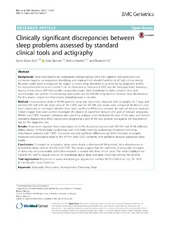| dc.contributor.author | Blytt, Kjersti Marie | en_US |
| dc.contributor.author | Bjorvatn, Bjørn | en_US |
| dc.contributor.author | Husebø, Bettina | en_US |
| dc.contributor.author | Flo, Elisabeth | en_US |
| dc.date.accessioned | 2018-08-28T09:34:56Z | |
| dc.date.available | 2018-08-28T09:34:56Z | |
| dc.date.issued | 2017-10-27 | |
| dc.Published | Blytt k, Bjorvatn B, Husebø BS, Flo E. Clinically significant discrepancies between sleep problems assessed by standard clinical tools and actigraphy. BMC Geriatrics. 2017;17:253 | eng |
| dc.identifier.issn | 1471-2318 | |
| dc.identifier.uri | https://hdl.handle.net/1956/18288 | |
| dc.description.abstract | Background: Sleep disturbances are widespread among nursing home (NH) patients and associated with numerous negative consequences. Identifying and treating them should therefore be of high clinical priority. No prior studies have investigated the degree to which sleep disturbances as detected by actigraphy and by the sleep-related items in the Cornell Scale for Depression in Dementia (CSDD) and the Neuropsychiatric Inventory – Nursing Home version (NPI-NH) provide comparable results. Such knowledge is highly needed, since both questionnaires are used in clinical settings and studies use the NPI-NH sleep item to measure sleep disturbances. For this reason, insight into their relative (dis)advantages is valuable. Method: Cross-sectional study of 83 NH patients. Sleep was objectively measured with actigraphy for 7 days, and rated by NH staff with the sleep items in the CSDD and the NPI-NH, and results were compared. McNemar's tests were conducted to investigate whether there were significant differences between the pairs of relevant measures. Cohen's Kappa tests were used to investigate the degree of agreement between the pairs of relevant actigraphy, NPI-NH and CSDD measures. Sensitivity and specificity analyses were conducted for each of the pairs, and receiver operating characteristics (ROC) curves were designed as a plot of the true positive rate against the false positive rate for the diagnostic test. Results: Proxy-raters reported sleep disturbances in 20.5% of patients assessed with NPI-NH and 18.1% (difficulty falling asleep), 43.4% (multiple awakenings) and 3.6% (early morning awakenings) of patients had sleep disturbances assessed with CSDD. Our results showed significant differences (p<0.001) between actigraphy measures and proxy-rated sleep by the NPI-NH and CSDD. Sensitivity and specificity analyses supported these results. Conclusions: Compared to actigraphy, proxy-raters clearly underreported NH patients' sleep disturbances as assessed by sleep items in NPI-NH and CSDD. The results suggest that the usefulness of proxy-rater measures of sleep may be questionable and further research is needed into their clinical value. The results highlight the need for NH staff to acquire and act on knowledge about sleep and sleep challenges among NH patients. | en_US |
| dc.language.iso | eng | eng |
| dc.publisher | BioMed Central | eng |
| dc.rights | Attribution CC BY | eng |
| dc.rights.uri | http://creativecommons.org/licenses/by/4.0 | eng |
| dc.subject | Actigraphy | eng |
| dc.subject | Proxy-rating | eng |
| dc.subject | Nursing home | eng |
| dc.subject | Dementia | eng |
| dc.subject | Sleep | eng |
| dc.title | Clinically significant discrepancies between sleep problems assessed by standard clinical tools and actigraphy | en_US |
| dc.type | Peer reviewed | |
| dc.type | Journal article | |
| dc.date.updated | 2018-03-07T11:12:43Z | |
| dc.description.version | publishedVersion | en_US |
| dc.rights.holder | Copyright 2017 The Author(s) | |
| dc.identifier.doi | https://doi.org/10.1186/s12877-017-0653-7 | |
| dc.identifier.cristin | 1517658 | |
| dc.source.journal | BMC Geriatrics | |

